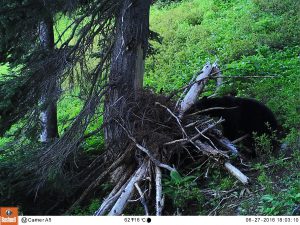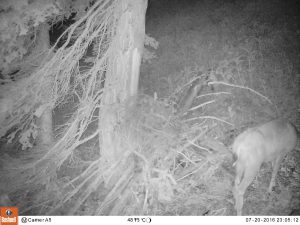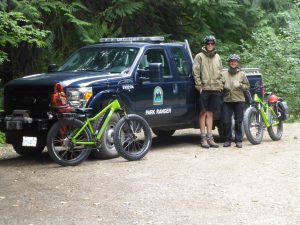A Weekend with BC Park Rangers in the Skagit Valley
Categories:
Situated between the areas of Chilliwack and Hope lie 20 protected areas that BC Park Rangers in the South Fraser area have the pleasure of looking after. Skagit Valley Provincial Park located nearly 40km South East of Hope provides Rangers with a diverse scope of field work. Last week, Park Rangers had the opportunity to spend 2 days working in this unique park.
Day 1: BC Park Rangers Stephanie and Owen hike to a sub-alpine area of the park to retrieve photos from a wildlife camera set up as part of a wildlife monitoring project jointly established between the US National Park Service and BC Parks. This project, funded by the Skagit Environmental Endowment Commission, allows biologists to gain a better understanding on the behaviour and movement of large carnivores between the two countries. A month earlier, the camera site was set up in an area selected for its abundance of animal sign. By piling together large branches and logs and scenting the area, Rangers were able to create a simulated prey burial site -bears will often bury prey as a way to hide and preserve a carcass. Today, we check the photos, replace the batteries in the camera, and apply a new scented lure to the site. Photogenic wildlife caught on camera this month include mule deer and black bear.


After returning down to the Skagit River valley, Park Rangers were able to catch an interpretative presentation at International Point from famed BC Parks Interpreter AJ and US National Park Service Interpreter Laura, before settling down for an early night.

Day 2: Today, Rangers set out with chainsaws on the historic Centennial Trail to make one final pass before the Fat Dog 120 mile trail race winds its way onto the trail in 7 days. New to the South Fraser area this year, electric bicycles provide an efficient way for Rangers to move heavy gear in an efficient and green manner. On this day, 25 trees are bucked off 15km of trail. The Centennial Trail which was once used as a corridor for prospectors looking to strike it rich on Shawatum Mountain now provides hikers with an opportunity to see a plethora of flora and fauna that call this dry belt of coastal Douglas-fir forest home.





